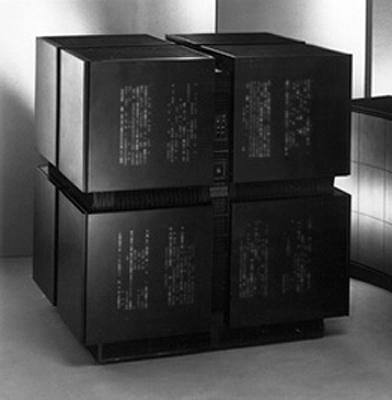Tamiko Thiel:
The Connection Machine
o Main Page
o Articles
o Images
o CM-1 t-shirt
[ Email
]
[ Portfolio
]
The Connection Machines CM-1 and CM-2

[ NEW: the CM-1 t-shirt has been re-issued! ]
The Connection Machine was the first commercial computer designed expressly to work on simulating intelligence and life. A massively parallel supercomputer with 65,536 processors, it was the brainchild of Danny Hillis, conceived while he was a graduate student under Marvin Minsky at the MIT Artificial Intelligence Lab.
Departing from conventional computer architecture of the time, it was modeled on the structure of a human brain: Rather than relying on a single powerful processor to perform calculations one after another, the data was distributed over the tens of thousands of processors, all of which could perform calculations simultaneously. The structures for communication and transfer of data between processors could change as needed depending on the nature of the problem, making the mutability of the connections between processors more important than the processors themselves, hence the name "Connection Machine".
From 1983-1985 I directed the packaging and industrial design of the Connection Machine CM-1 at Thinking Machines Corporation, working with industrial design consultants Allen Hawthorne and Gordon Bruce, and mechanical engineer consultant Ted Bilodeau. The CM-2, released in 1987, was a more advanced successor contained in the same physical package.
The form of the machine was to express both its function and the passions of its creators: the dream of producing a "Machina Sapiens," a new genus of living, thinking machines.
At its height, there were Connection Machines at 70 installations around the world. The following machines have been preserved in museum collections:
- Connection Machine CM-1 in the Computer History Museum, Mountain View, San Francisco Bay Area, CA.
- Connection Machine CM-2 in the Museum of American History, Smithsonian Institution, Washington DC.